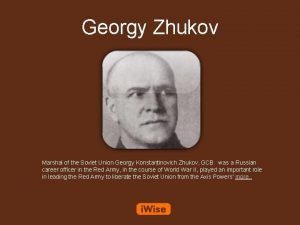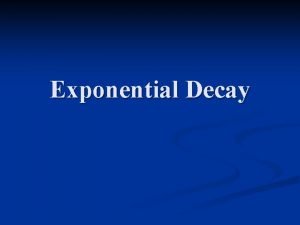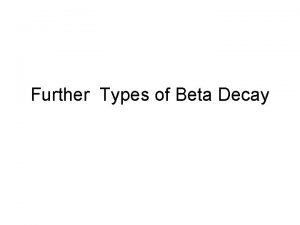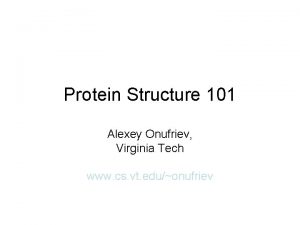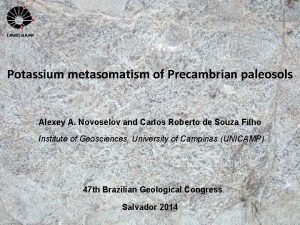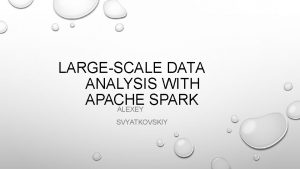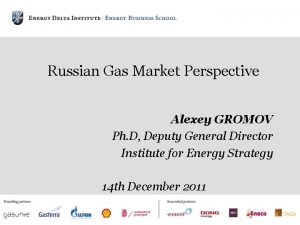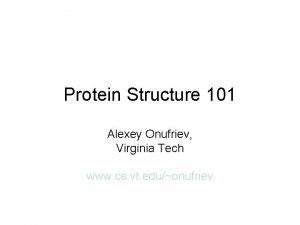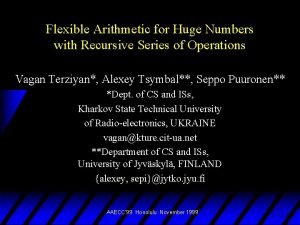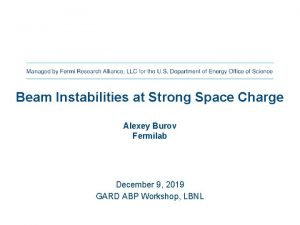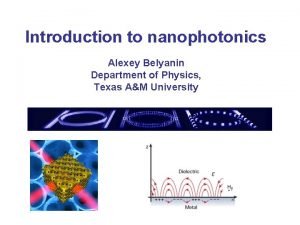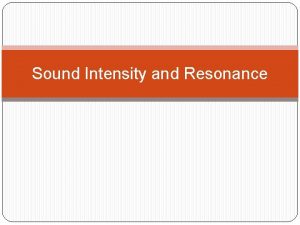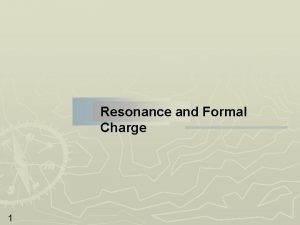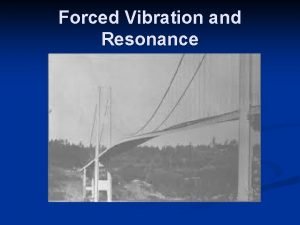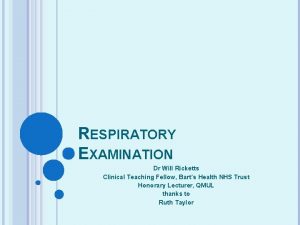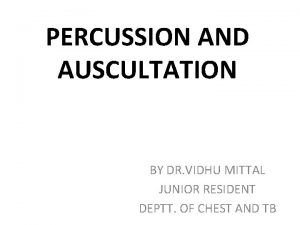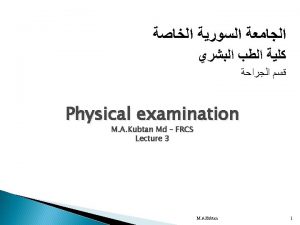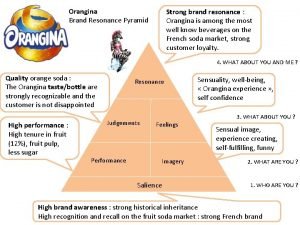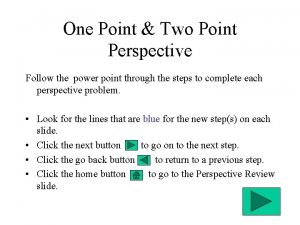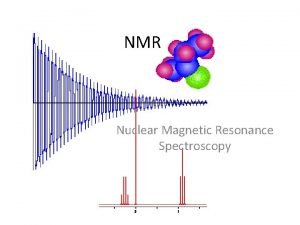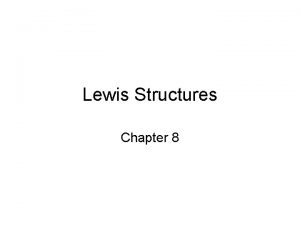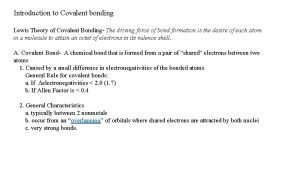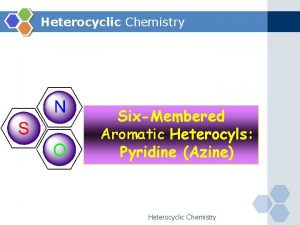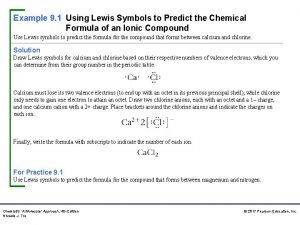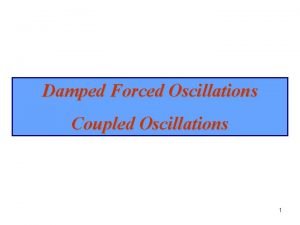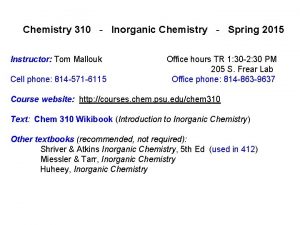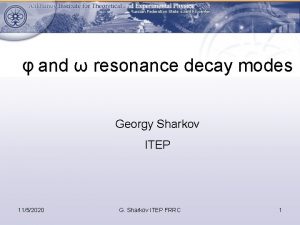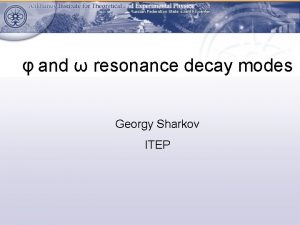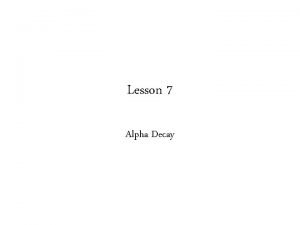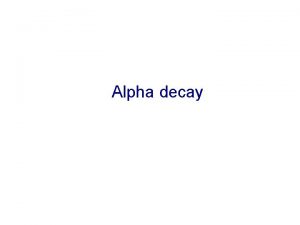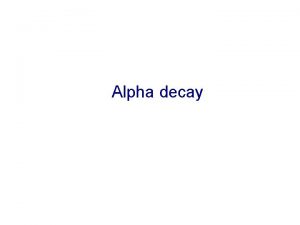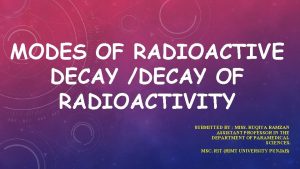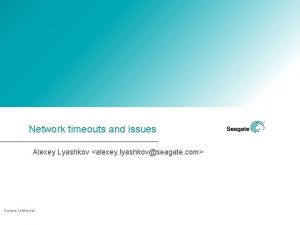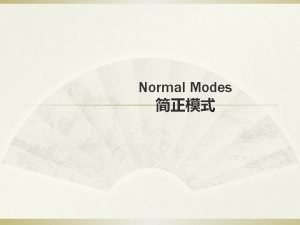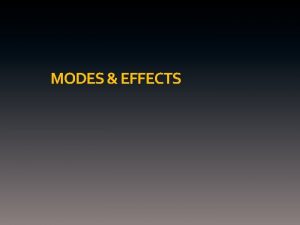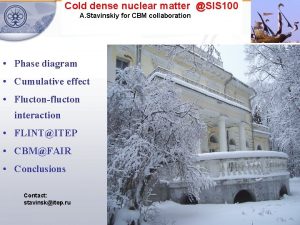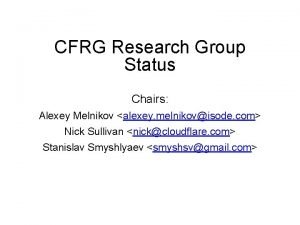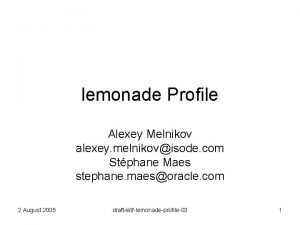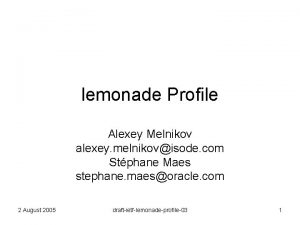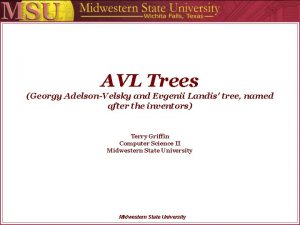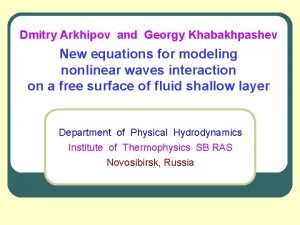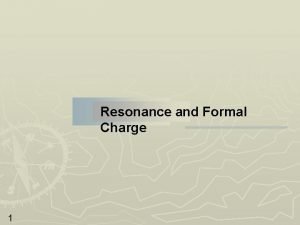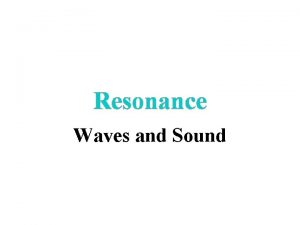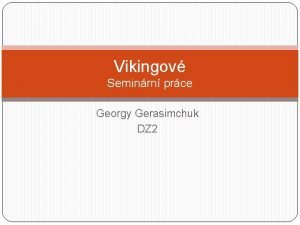and resonance decay modes Alexey Stavinskiy Georgy Sharkov





















![Direct photons analysis ω a 1(1260) η' Re: [URQMD] ftn 15 (fwd) K* f Direct photons analysis ω a 1(1260) η' Re: [URQMD] ftn 15 (fwd) K* f](https://slidetodoc.com/presentation_image_h2/c7c9ca8ef1af1f70e6d6b43d6fce1cfc/image-22.jpg)











- Slides: 33

φ and ω resonance decay modes Alexey Stavinskiy, Georgy Sharkov ITEP X GDRE meeting

NI CA Phase diagram of nuclear matter 10/16/2021 G. Sharkov ITEP GDRE 2

, ω resonances If resonance decays before kinetic freeze-out Possible rescattering of hadronic daughters Reconstruction probability decrease for hadronic mode A. V. Stavinsky, Acta Phys. Polon B 40; 1179 -1184, 2009 ω(782) π+ π- π0 B. R. 0. 89 ω(782) π+ π- B. R. 0. 017 ω(782) π0 B. R. 0. 089 ω(782) e+e- B. R. 0. 000072 φ(1020) K+ K- B. R. 0. 49 φ(1020) η B. R. 0. 013 φ(1020) e+e- B. R. 0. 000297 10/16/2021 G. Sharkov ITEP GDRE (c = 23 fm) (c = 44 fm) 3

t hadrons with &without QGP quarks&gluons 10/16/2021 G. Sharkov ITEP GDRE 4

Simple estimation • Put resonance in center of collision with p=0 • Look for decay probability after some reasonable time total resonance decay to particular mode cτ, fm 15 fm/c 30 fm/c BR 15 fm/c 30 fm/c φ 44 28, 9% 49, 4% φ→KK 0, 49 14, 2% 24, 2% ω 23 47, 9% 72, 9% ω→ππ 0, 017 0, 8% 1, 2% 10/16/2021 G. Sharkov ITEP GDRE 5

Model l 0~cτβ/√(1 -β 2) ~ ~(β=1/3 for this estimate)~ ~15 fm(for φ) & 8 fm(for ω) l 0 φ li η η li~2 fm for any hadron & 1 fm for any pair of hadrons l hadronization 10/16/2021 G. Sharkov ITEP GDRE Kinetic freeze-out 6

Model • Upper line – lepton mode Splitting – two hadron and hadron-photon modes l -decay products trajectory length within matter φ β= 1/3 ω l, fm 10/16/2021 G. Sharkov ITEP GDRE 7

Is it really possible measurement? • Existing data from PHENIX& STAR – Bφ/ e+e– Bφ K+K– B p+p-p 0, p 0 – Bφ η ? 10/16/2021 G. Sharkov ITEP GDRE 8

Φ(1020) K+ KΦ(1020) e+e- B. R. 0. 49 c = 44 fm B. R. 0. 000296 c = 44 fm d+Au PHENIX Φ K+ KSTAR Preliminary √s. NN = 200 Ge. V Au+Au 10/16/2021 G. Sharkov ITEP GDRE Φ e+e- PHENIX √s. NN = 200 Ge. V 9

ω(782) π+ π- π0 B. R. 0. 89 c = 23 fm ω(782) π0 B. R. 0. 089 c = 23 fm PHENIX η, ω π+ π- π0 η(547) π+ π- π0 B. R. 0. 23 c = 167225 fm p+p Au+Au p+p ω π0 PHENIX ω π0 10/16/2021 √s. NN = 200 Ge. V PHENIX G. Sharkov ITEP GDRE 10

Φ Production K+K- and e+e- e+ e- K+ K- • The leptonic channel yield is a little higher than hadronic channel • More accurate measurement is required to confirm whethere is branch ratio modification Y. Nakamiya, for the PHENIX collaboration QM 2008, India 10/16/2021 G. Sharkov ITEP GDRE 12

Yield comparison between e+e- and K+KComparison of integrated yield is not enough, because effect depend on the velocity of resonance, thus pc. m. region. Low pc. m. mesons tend to decay inside the hot/dense matter Low pc. m. High pc. m. Thus, pc. m. -dependent information is essential for comparison. 10/16/2021 G. Sharkov ITEP GDRE 13

d. N/d. IM, 1/0. 1 Me. V 10 K Au. Au@25 AGe. V EPOS events 10/16/2021 G. Sharkov ITEP GDRE 14

d. N/d. IM, 1/0. 1 Me. V e+e-, π+π- Invariant mass 10/16/2021 ω→π+πω→e+e- G. Sharkov ITEP GDRE 15

CBM simulation Input info PLUTO generator (generates one particle from 25 AGe. V Au. Au artificial fireball) 104 events for each resonance decay mode Setup: Target, Magnet, MVD, STS, RICH, TOF, TRD, ECAL(Full. MC) CBMROOT (DEC 08), standard cuts 10/16/2021 G. Sharkov ITEP GDRE 16

dielectrons Mean 0. 7791 Sigma 0. 0101 Mean 1. 01701 Sigma 0. 0101 IM e+e- , Ge. V/c 2 • 28% of ω reconstructed 10/16/2021 , Ge. V/c 2 • 27% of φ reconstructed G. Sharkov ITEP GDRE 18

Mean 1. 0198 Sigma 0. 0039 • 14% of φ reconstructed • Need to play with ID (K+hno ID, hno ID+hno ID) 10/16/2021 G. Sharkov ITEP FRRC 19

Conclusions • Comparison of vector mesons decay modes is proposed to study. Pc. m. dependence. • Au. Au collisions simulated using EPOS – Hadronic and leptonic modes – mixed modes (ω→πoγ; φ→ηγ): combinatorics • PLUTO e+e-(ω , φ), K+K-(ω, φ) simulated and reconstructed in CBMROOT 10/16/2021 G. Sharkov ITEP GDRE 20

TO DO • HKM calculations. (Yu. Sinyukov, Yu. Karpenko) – Magnitude of the effect – Energy dependence? P 1(p 1) & P 2(p 2) − escape probability for i-th decay product after decay • EPOS 2 realistic event-by-event calculations – Comparison with RHIC data – RHIC energy scan, FAIR, NICA 10/16/2021 G. Sharkov ITEP GDRE 21

10/16/2021 G. Sharkov ITEP GDRE 22

• 14% of φ reconstructed • Need to play with ID (K+hno ID, hno ID+hno ID) 10/16/2021 G. Sharkov ITEP GDRE 24
![Direct photons analysis ω a 11260 η Re URQMD ftn 15 fwd K f Direct photons analysis ω a 1(1260) η' Re: [URQMD] ftn 15 (fwd) K* f](https://slidetodoc.com/presentation_image_h2/c7c9ca8ef1af1f70e6d6b43d6fce1cfc/image-22.jpg)
Direct photons analysis ω a 1(1260) η' Re: [URQMD] ftn 15 (fwd) K* f 1(1285) • Only from decay Ur. QMD code cheers, Marcus Bleicher" • 2 γγ elastic scatterings(? !) 10/16/2021 "hm, yes photons are mesons in urqmd. however, photons should not be calculated within the urqmd, but explicitely outside with a different code. everybody should ignore all processes with photons involved. we will move them out of the model in the next version. G. Sharkov ITEP GDRE 33

Formulas 10/16/2021 G. Sharkov ITEP GDRE 34 Stavinskiy, ITEP, 10. 06. 08

Electron, hadron and photon in PHENIX / e+e- e+ • PHENIX acceptance -0. 35 < η < 0. 35 2 x 90°in azimuthal angle for two arms • Event selection BBC e- , • Electron ID RICH EMCal Momentum Electron ID K + K- • photon ID EMCal p+p-p 0, p 0 • Hadron ID TOF EMCal-TOF Energy K+ 10/16/2021 Momentum Hadron ID K- p 0 p+ p G. Sharkov ITEP GDRE Momentum Hadron ID 35

Extended Consistency between K+K- analysis K+K- and e+e. Double ID analysis K+ K- candidates d+Au no ID analysis h+ candidates Single ID analysis K+ or K- 0 -20% h- h+ or h- candidates No No ID ID Single ID ID Double ID ID e+ e- M. B. p+p • K+K- measurements have been extended to both higher and lower new methods, no kaon and single kaon ID methods. - and T using Inpp+p, spectra of e+ei. e. K+K-IDshow reasonable agreement! 10/16/2021 G. analyses Sharkov ITEP are GDREconsistent with each other. 36 • The three independent kaon

Spectra comparison between e+e- and K+K- Au+Au e+e- Au. Au MB e+e- 20 -40% x 10 -3 e+e- 40 -92% x 10 -1 K+K- Au. Au MB (no PID) K+K- Au. Au MB (double PID) K+K- Au. Au MB (PRC 72 014903) K+K- 20 -40% x 10 -3 (double PID) K+K- 40 -92% x 10 -1 (PRC 72 014903) M. B. 20 -40% 40 -92% Errors are too large to make any. ITEP clear 10/16/2021 G. Sharkov GDRE statement about the comparison of spectra for e+e- and K+K-. 37

Yield comparison between e+e- and K+KQuestion 1’: Have we observed changes of yield between e+e- and K+K- ? Comparison of integrated yield is not enough, because mass modification effects depend on the p. T region. Low p. T mesons tend to decay inside the hot/dense matter Low p. T High p. T In addition, To determine the integrated yield, an extrapolation to lower p. T is needed. There is a large uncertainty in the calculation. Thus, p. T-dependent information is essential for comparison. Now, we should ask 10/16/2021 G. Sharkov ITEP GDRE Have we observed changes of spectra between e+e- and K+K 38 - ?

What is the difference? • Modes absorbtion vs Mass modification – Standard mesons vs modified mesons – φ→KK & φ→η • Modes absorbtion vs K/K* ratio – Lepton modes vs thermal model – Hadron stage vs equilibrium stage • Modes absorbtion vs both other approaches – Internal cross-check - 3 modes 10/16/2021 G. Sharkov ITEP GDRE 39 Stavinskiy, ITEP, 10. 06. 08

Real σMN in matter can differ from that in free space • ω photoproducton on nuclear targets (ELSA) M. Kotulla et al. , Ar. Xiv: nucl-ex/08020980 σωN ≈ 70 mb (in nuclear medium, 0. 5 < P <1. 6 Ge. V/c) σωN ≈ 25 mb (in free space - the model calculations) photoproducton on nuclear targets • photoproducton on nuclear targets T. Ishikawa et al. , Phys. Lett. B 608, 215, (2005) σφN= 35 ± 14 mb (in nuclear medium) σφN ≈ 10 mb (in free space) “φ-puzzle” 10/16/2021 G. Sharkov ITEP GDRE 40

Measurements of w in wide p. T range p. T spectra of w are measured for several decay modes in d+Au and p+p. w p 0 d. Au MB (PRC 75 151902) w p 0 p+p- d. Au MB(PRC 75 151902) w e+e- pp MB (PHENIX preliminary) w p 0 pp MB (PRC 75 151902) w p 0 p+p- pp MB(PRC 75 151902) w p 0 pp ERT (PHENIX preliminary) w p 0 p+p- pp ERT (PHENIX preliminary) w d+Au p+p 10/16/2021 G. Sharkov ITEP GDRE 41 Spectra show good agreement among several decay channels.

Branching ratios as an instrument for density integral measurements mesons ( mesons) new source of information Interplay between different ALICE subdetectors(? ) 10/16/2021 G. Sharkov ITEP GDRE 42 Stavinskiy, ITEP, 9. 04. 08

10/16/2021 G. Sharkov ITEP GDRE 43

Why ? (common part) The meson was proposed in the middle of 80’(Koch, Muller, Rafelski PR 142, Shor. PRL 54) as one of the most promising QGP messengers because of the following reasons: – an enhancement of –meson, as well as other strange hadrons in QGP phase – interaction cross section is small and will keep information about the early hot and dense phase – meson spectrum is not distorted by feeddown from resonance decays – strangeness local conservation for 10/16/2021 G. Sharkov ITEP GDRE 44 Stavinskiy, ITEP, 9. 04. 08
 Georgy zhukov
Georgy zhukov Decay factor example
Decay factor example Beta minus decay vs beta plus decay
Beta minus decay vs beta plus decay Alexey onufriev
Alexey onufriev Alexey novoselov
Alexey novoselov Alexey svyatkovskiy
Alexey svyatkovskiy Alexey gromov
Alexey gromov Alexey onufriev
Alexey onufriev Inverse operations
Inverse operations Alexey burov
Alexey burov Alexey ustinov
Alexey ustinov Introduction to nanophotonics
Introduction to nanophotonics Sound intensity and resonance
Sound intensity and resonance Resonance and formal charge
Resonance and formal charge Forced vibration and resonance
Forced vibration and resonance Closed and open pipe resonance
Closed and open pipe resonance Forced vibration and resonance
Forced vibration and resonance Brand resonance and the brand value chain
Brand resonance and the brand value chain Brand resonance
Brand resonance Delocalization and resonance
Delocalization and resonance Tactile fremitus test
Tactile fremitus test Percussion tympanic
Percussion tympanic Percussion tapping
Percussion tapping Lewis structure for chocl
Lewis structure for chocl Resonance brand
Resonance brand Two point perspective stairs
Two point perspective stairs Larmor frequency
Larmor frequency No arrows
No arrows Co lewis dot structure
Co lewis dot structure Lewis concept of covalent bond
Lewis concept of covalent bond Chemical properties of pyridine
Chemical properties of pyridine Ocn- resonance structures
Ocn- resonance structures Coupled oscillations
Coupled oscillations Ocn- resonance
Ocn- resonance
